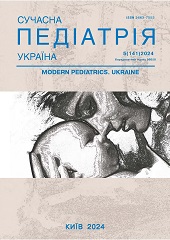Psychological testing in children with elevated blood lead level: the effect of spirulina
DOI:
https://doi.org/10.15574/SP.2024.5(141).3033Keywords:
lead poisoning, children, cognitive disorders, psychological testing, spirulinaAbstract
The search for effective and safe remedies to reduce the negative effects of lead on a child’s cognitive sphere is an urgent problem.
Aim - to analyze changes in psychological testing indicators in children with elevated blood lead level and the effect of spirulina on them.
Materials and methods. A total of 33 children aged 7 to 15 years were examined. The children were divided into 2 groups depending on the lead level in their blood: up to and including 49 μg/l (control group) and from 50 μg/l or more (main group). Statistical processing of the results was carried out by the method of variation series using the Student's t-test, and analysis of variance was carried out using the F-criterion.
Results. In children with elevated blood lead level, there was a significant increase in cognitive impairment (memory and attention) compared to control scores. According to WHO recommendations, nutritional intervention was selected to correct the identified changes. For this purpose, children of the main group received a course of spirulina according to the following scheme: 0.5 g twice a day for 10 days, then 1 g twice a day for 20 days. As a result, the level of lead in the blood of children in this group decreased: (62.64±5.73) μg/l, compared to the initial value (75.55±1.99) μg/l. Cognitive indicators also improved: the number of correctly reproduced images significantly increased and the time to switch attention decreased, compared to the indicators before taking microalgal drugs.
Conclusions. Spirulina has a neuroprotective effect in children with chronic lead intoxication. The analysis of variance confirmed this conclusion: the score on the number of correctly reproduced images according to criterion F was 4.58. The effect on the time of switching attention according to criterion F was 8.58.
The research was carried out in accordance with the principles of the Declaration of Helsinki. The research protocol was approved by the Local Ethics Committee of the participating institution. The informed consent of the patient was obtained for conducting the studies.
No conflict of interests was declared by the authors.
References
Alhashimi A, Abdelkareem A, Amin MA, Nowwar AI et al. (2024). Eco-friendly approach to decrease the harmful effects of untreated wastewater on growth, yield, biochemical constituents, and heavy metal contents of carrot (Daucus carota L.). Environmental science and pollution research international. 31: 14043-14058. https://doi.org/10.1007/s11356-024-31869-2
Bortolini DG, Maciel GM, Fernandes IAA, Pedro AC et al. (2022). Functional properties of bioactive compounds from Spirulina spp. Current status and future trends. Food chemistry. Molecular sciences. 5: 100134. https://doi.org/10.1016/j.fochms.2022.100134
Hnidoi I. (2023). Blood lead level and cognitive performance in Ukrainian schoolchildren. Psychosomatic Medicine and General Practice. 8(1): e0801376. https://doi.org/10.26766/PMGP.V8I1.376
Hnidoi IM, Hnida NI. (2023). Spirulina in the rehabilitation of children with elevated blood lead concentration. Scientific Bulletin of the Uzhhorod University. Series «Medicine». 1(67): 85-88. https://doi.org/10.32782/2415-8127.2023.67.15
Horlenko VM, Ostrova VD, Sosnovenko NV, Tkachuk II. (2018). Application of diagnostic minima in the activities of psychological service workers: method. rec. Za zah. red. V.H. Panka. Kyiv: UNMTs praktychnoi psykholohii i sotsialnoi roboty: 106.
Maddiboyina B, Vanamamalai HK, Roy H, Ramaiah Gandhi S et al. (2023). Food and drug industry applications of microalgae Spirulina platensis: A review. Journal of basic microbiology. 63(6): 573-583. https://doi.org/10.1002/jobm.202200704
Maidoumi S, Ouaziz CR, Ouisselsat M, El Maouaki A et al. (2022). Iron deficiency and cognitive impairment in children with low blood lead levels. Toxicology reports. 9: 1681-1690. https://doi.org/10.1016/j.toxrep.2022.08.008
Mallamaci R, Storelli MM, Barbarossa A, Messina G et al. (2023). Potential Protective Effects of Spirulina (Spirulina platensis) against In Vitro Toxicity Induced by Heavy Metals (Cadmium, Mercury, and Lead) on SH-SY5Y Neuroblastoma Cells. International journal of molecular sciences. 24(23): 17076. https://doi.org/10.3390/ijms242317076
Ministry of Health of Ukraine. (2023). Lead poisoning: symptoms, health effects, and prevention. State Institution "Public Health Center of the Ministry of Health of Ukraine". URL: https://www.phc.org.ua/news/otruennya-svincem-simptomi-naslidki-dlya-zdorovya-ta-profilaktika.
Shukla S, Mbingwa G, Khanna S, Dalal J et al. (2023). Environment and health hazards due to military metal pollution: A review. Environmental Nanotechnology, Monitoring & Management. 20: 100857. https://doi.org/10.1016/j.enmm.2023.100857
Sorrenti V, Castagna DA, Fortinguerra S, Buriani A et al. (2021). Spirulina Microalgae and Brain Health: A Scoping Review of Experimental and Clinical Evidence. Marine drugs. 19(6): 293. https://doi.org/10.3390/md19060293
WHO. (2021). Guideline for the clinical management of exposure to lead. Geneva: World Health Organization. URL: https://www.who.int/publications/i/item/9789240037045.
Downloads
Published
Issue
Section
License
Copyright (c) 2024 Modern pediatrics. Ukraine

This work is licensed under a Creative Commons Attribution-NonCommercial 4.0 International License.
The policy of the Journal “MODERN PEDIATRICS. UKRAINE” is compatible with the vast majority of funders' of open access and self-archiving policies. The journal provides immediate open access route being convinced that everyone – not only scientists - can benefit from research results, and publishes articles exclusively under open access distribution, with a Creative Commons Attribution-Noncommercial 4.0 international license (СС BY-NC).
Authors transfer the copyright to the Journal “MODERN PEDIATRICS. UKRAINE” when the manuscript is accepted for publication. Authors declare that this manuscript has not been published nor is under simultaneous consideration for publication elsewhere. After publication, the articles become freely available on-line to the public.
Readers have the right to use, distribute, and reproduce articles in any medium, provided the articles and the journal are properly cited.
The use of published materials for commercial purposes is strongly prohibited.

